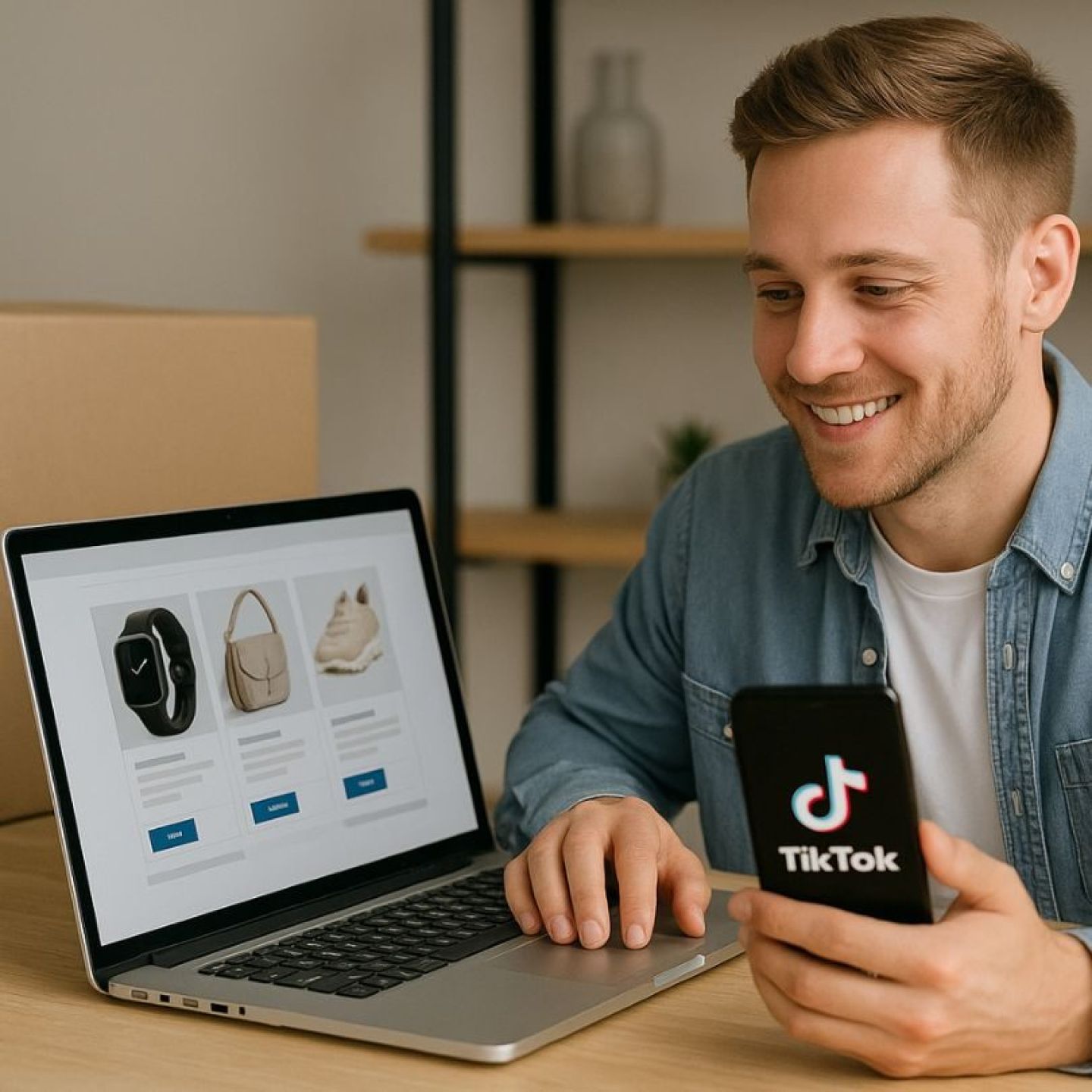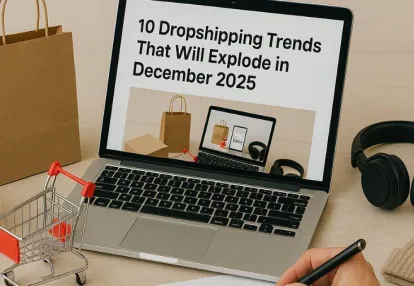
Наши инструменты отслеживают миллионы TikTok-объявлений из более чем 55 стран. Крупнейшая библиотека TikTok-рекламы в сфере e-commerce и мобильных приложений!
Попробуйте БЕСПЛАТНОПолная зависимость от TikTok для трафика в дропшиппинге становится все более рискованной. Изменения алгоритмов, рост стоимости рекламы и насыщение платформы заставляют умных предпринимателей диверсифицировать свои маркетинговые стратегии. Вот где нативная реклама становится вашим секретным оружием для масштабирования продаж через дропшиппинг за пределами одной платформы.
Нативная реклама органично вписывается в контент, которым уже пользуются ваши потенциальные клиенты — будь то лента социальных сетей, статьи на издательских сайтах или поиск товаров в интернете. В отличие от традиционной баннерной рекламы, которая кричит «реклама», нативные объявления выглядят естественно и не раздражают, что и объясняет их высокую конверсию для бизнеса в сфере дропшиппинга.
С правильной стратегией вы можете найти самые продаваемые товары для дропшиппинга и управлять своим магазином с одной платформы.
Вот что вы узнаете из этого руководства:
Вы узнаете, как построить устойчивую многоканальную рекламную стратегию, которая уменьшит вашу зависимость от одной платформы и значительно увеличит доход от дропшиппинга.
Нативная реклама — это промо-контент, созданный в соответствии с внешним видом, стилем и функционалом платформы, на которой она размещается. В отличие от традиционной баннерной рекламы, кричащей «реклама», такие объявления органично вписываются в ленту, результаты поиска или контент-страницы. Вы узнаете их по надписям «Спонсируется» или «Реклама», но визуально они соответствуют стилю окружающего органического контента.
В дропшиппинге нативная реклама работает, привлекая внимание, не нарушая пользовательский опыт. Когда кто-то просматривает ленту в социальных сетях или читает статью, ваш товар появляется как естественная часть процесса. Такой подход снижает усталость от рекламы и повышает вероятность вовлечения, поскольку вы доставляете предложение туда, где потенциальные клиенты уже находятся, в привычном и удобном формате.
Разные форматы решают разные задачи в вашей стратегии дропшиппинга:
Программатик-нативная реклама автоматизирует процесс покупки объявлений через платформы для покупателей рекламы (DSP). Эти системы участвуют в торгах в реальном времени за доступные рекламные места на тысячах веб-сайтов и приложений.
Вы задаете параметры таргетинга — демографию, интересы, поведение при просмотре, — и DSP автоматически размещает ваши объявления там, где они покажут лучший результат. Такая автоматизация оптимизирует охват и экономическую эффективность, позволяя масштабировать кампании без необходимости ручных переговоров с каждым издателем.
Преимущества нативной рекламы выходят далеко за рамки простой видимости. Внедряя нативную рекламу в свою стратегию дропшиппинга, вы используете маркетинговый подход, который кардинально меняет то, как клиенты взаимодействуют с вашим брендом.
Нативная реклама не прерывает процесс серфинга — она его улучшает. Такая бесшовная интеграция создаёт условия, при которых потенциальные клиенты естественным образом взаимодействуют с вашими товарами, не вызывая защитной реакции, которую часто провоцируют традиционные баннеры. Вы не навязываете своё сообщение пользователям, вы подаёте его как часть их обычного потребления контента. Такой подход формирует доверие теми способами, которым баннерная реклама просто не может соперничать.
Психология здесь проста: люди доверяют контенту, который выглядит органичным для платформы, которую они используют. Когда ваш товар появляется в виджете рекомендаций рядом с редакционным контентом или ваше видеоавтоматически воспроизводится в социальной ленте, пользователи воспринимают это как менее навязчивое и более надёжное. Такое восприятие напрямую приводит к более высоким показателям вовлечённости и улучшению конверсии в рост продаж дропшиппинга.
Возможности таргетированной рекламы — ещё одно существенное преимущество. Платформы нативной рекламы собирают обширные поведенческие данные, позволяя вам точно сегментировать аудиторию:
Вы можете достигать клиентов в самый подходящий момент, когда они наиболее восприимчивы к вашему сообщению. Пользователь, читающий статью об организации дома, видит рекламу вашего решения для хранения. Тот, кто просматривает контент о фитнесе, встречает ваше спортивное оборудование. Такой уровень персонализации обеспечивает более высокие показатели кликабельности и лучшую отдачу от рекламных расходов по сравнению с широкомасштабными рекламными подходами.
Использование данных в платформах нативной рекламы также означает постоянную оптимизацию. Системы реального ценообразования корректируют размещение вашей рекламы на основе показателей эффективности, обеспечивая сосредоточение вашего бюджета на самых конверсионных аудиториях и размещениях.
Масштабирование за пределами TikTok: использование нативной рекламы для роста продаж в дропшиппинге требует стратегического подхода, выходящего за рамки простого запуска кампаний. Вам необходимо внедрить проверенные тактики, которые максимизируют возврат на рекламные расходы и создают устойчивый рост для вашего дропшиппинг-бизнеса.
Оптимизация для мобильных устройств не является необязательной — она критически важна. Большинство потенциальных клиентов просматривают контент и совершают покупки на смартфонах, что делает проектирование с приоритетом мобильных устройств необходимым элементом масштабирования продаж в дропшиппинге с помощью нативной рекламы. Ваши рекламные материалы должны быстро загружаться, корректно отображаться на экранах меньшего размера и содержать четкие интерактивные кнопки призыва к действию. Тестируйте рекламу на различных устройствах и экранах, чтобы обеспечить стабильную производительность.
Шаблонные посадочные страницы снижают конверсию. Вам нужны персонализированные посадочные страницы, соответствующие конкретному рекламному материалу и сообщению, на которое перешел пользователь. Каждая посадочная страница должна включать:
Ваша нативная реклама должна органично вписываться в среду платформы. Реклама, эффективная на новостном сайте, не обязательно будет работать на блоге о стиле жизни. Изучайте стиль, тон и визуальную эстетику контента на каждой площадке и адаптируйте свои рекламные материалы соответствующим образом. Такое контекстное соответствие повышает вовлеченность и снижает усталость от рекламы.
Ретаргетинг аудитории, уже взаимодействовавшей с вашим брендом, обеспечивает более высокие коэффициенты конверсии при меньших затратах. Настройте отслеживание пикселя для сбора данных о посетителях, которые просматривали товары, но не совершили покупку, и показывайте им персонализированную нативную рекламу с изображением точно тех товаров, которые они просматривали. Этот подход помогает оставаться в центре внимания потребителей и подталкивает сомневающихся покупателей к завершению покупки.
Ежедневно отслеживайте свои показатели CPM, CPC, CTR, конверсии и ROAS. Выявляйте неэффективные варианты рекламы и быстро останавливайте их, одновременно увеличивая бюджет на наиболее успешные комбинации. Систематически тестируйте разные заголовки, изображения и предложения, чтобы определить, что лучше всего резонирует с вашей целевой аудиторией.
Полная зависимость от TikTok для трафика вашего дропшиппинга создает опасную единую точку отказа. Изменения алгоритма, приостановка аккаунта или смена политики платформы могут разрушить ваш бизнес в одночасье. Реклама в нескольких каналах для дропшиппинга защищает ваши источники дохода и одновременно открывает новые пути привлечения клиентов, которых вы никогда не достигли бы через TikTok в одиночку.
Нативная реклама отлично подходит для создания согласованных кампаний на нескольких платформах, поскольку она естественным образом адаптируется к каждой среде. Вы можете размещать нативную рекламу в лентах Facebook и Instagram, имитирующую органические публикации, публиковать спонсируемый контент на таких сайтах, как BuzzFeed или Forbes, и использовать нативную рекламу в поиске Google, которая смешивается с органическими результатами. Каждый канал охватывает разные сегменты аудитории на различных этапах пути покупки.
Ваша стратегия нативной рекламы должна охватывать как минимум три отдельные категории каналов:
1. Социальные сети: Помимо TikTok, такие платформы, как Pinterest, Reddit и Twitter, предлагают форматы нативной рекламы, которые органично встраиваются в пользовательские ленты. Рекламные пины Pinterest отлично работают для поиска товаров в таких нишах, как интерьер и мода.
2. Поисковые системы: Нативная реклама в поиске Google отображается выше органических результатов и привлекает покупателей с высоким намерением, активно ищущих товары. Bing предлагает аналогичные позиции по более низким ценам, что делает его недооценённой возможностью для роста электронной коммерции с помощью нативной рекламы.
3. Публицистические сети: Платформы рекомендации контента, такие как Taboola и Outbrain, размещают вашу нативную рекламу на премиальных сайтах издателей, знакомя вашу продукцию с аудиторией, потребляющей соответствующий контент. Эти размещения повышают доверие за счёт ассоциации с авторитетными медиабрендами.
Ключ к успешным кампаниям в нескольких каналах — поддержание единого посыла при адаптации креативных элементов под уникальную среду каждой платформы. Вам нужно будет корректировать соотношение изображений, длину заголовков и стиль призывов к действию в зависимости от места размещения рекламы. Отслеживайте показатели эффективности отдельно для каждого канала, чтобы определить источники с наибольшей отдачей на рекламные вложения и соответствующим образом распределять бюджет.
Сфера нативной рекламы быстро развивается под влиянием технологических инноваций и изменения правил конфиденциальности. Понимание этих изменений позволит вашему дропшиппинг-бизнесу воспользоваться новыми возможностями и опережать конкурентов.
Креативный контент, созданный с помощью ИИ, трансформирует способы создания и размещения нативной рекламы. Модели GPT и аналогичные инструменты на базе искусственного интеллекта способны генерировать убедительные тексты объявлений, ориентированные на конкретные аудитории. Вы можете предоставлять этим системам описания ваших товаров, отзывы клиентов и рекомендации по стилю бренда, чтобы за считанные минуты получить десятки вариантов рекламных текстов. Технология анализирует данные об эффективности в режиме реального времени, выявляя те формулировки, которые вызывают наибольшую вовлеченность. Это означает, что вы больше не ограничены возможностями креативной команды — вы можете одновременно тестировать несколько подходов и масштабировать самые успешные.
Динамическая оптимизация текста выводит возможности ИИ на новый уровень. Современные платформы автоматически заменяют такие элементы, как цена, изображение товара и призывы к действию, в зависимости от поведения пользователя и контекста. Если пользователь просматривал похожие товары, в рекламе может подчеркиваться конкурентоспособная цена. Для новичков текст может акцентироваться на уникальных преимуществах продукта или социальном доказательстве. Такой уровень персонализации реализуется мгновенно на тысячах рекламных площадок, создавая индивидуальный опыт для каждого потенциального клиента.
Контекстная таргетинговая реклама с приоритетом конфиденциальности становится необходимостью по мере исчезновения сторонних файлов cookie и ужесточения правил конфиденциальности по всему миру. Теперь вы ориентируетесь на контент, который пользователь просматривает в данный момент, а не на историю его просмотров. Если кто-то читает статью о домашних тренировках, ваша нативная реклама спортивного оборудования появится в этом контексте — отслеживание не требуется. Такой подход уважает конфиденциальность пользователей, сохраняя при этом релевантность, и первые данные показывают, что он может соответствовать или даже превосходить эффективность традиционного поведенческого таргетинга.
Эти тенденции знаменуют фундаментальное изменение в работе нативной рекламы. Вы получаете более совершенные инструменты, адаптируясь при этом к цифровой среде, в которой приоритетами являются конфиденциальность, качество пользовательского опыта и прозрачность.
Ghost commerce дропшиппинг представляет собой бизнес-модель, при которой вы работаете без физического товара, полностью полагаясь на поставщиков третьих сторон для выполнения заказов непосредственно клиентам. Вы ведёте цифровой магазин—через социальные сети, веб-сайт или торговые площадки—в то время как ваши поставщики занимаются хранением, упаковкой и отправкой товаров. Эта модель требует эффективных цифровых маркетинговых стратегий в сфере дропшиппинга для привлечения трафика и увеличения конверсий без традиционных торговых точек.
Нативная реклама естественным образом встраивается в операции ghost commerce, поскольку она соответствует подходу, ориентированному на контент, который уже используется этими компаниями. Когда вы строите бренд без физического присутствия, ваш маркетинг становится полным опытом взаимодействия с клиентом. Нативная реклама позволяет вам:
Модель ghost commerce процветает благодаря скорости и адаптивности. Вы можете запускать новые товары, тестировать разных поставщиков и изменять ассортимент на основе анализа эффективности—всё это без риска, связанного с наличием запасов. Нативная реклама поддерживает эту гибкость, позволяя быстро обновлять креативы и тестировать аудиторию на различных платформах.
Масштабирование за пределами TikTok с помощью нативной рекламы для увеличения продаж дропшиппинга становится особенно эффективным в ghost commerce, поскольку вы не привязаны к алгоритму или аудитории одной платформы. Вы распространяете спонсируемый контент одновременно на издательских сетях, поисковых системах и в социальных сетях. Это многоканальное присутствие компенсирует отсутствие физических торговых точек, создавая множество цифровых точек соприкосновения, где потенциальные клиенты обнаруживают ваши товары в релевантных контекстах.
Ключевой момент заключается в поддержании согласованности таких нативных размещений при адаптации сообщений под уникальную аудиторию и стиль контента каждой платформы. Ваша ghost commerce операция обретает достоверность благодаря стратегической интеграции контента, а не традиционным методам создания бренда.
Отслеживание эффективности нативной рекламы выходит за рамки базовых метрик. Вам нужны сложные методы измерения, чтобы понять, что на самом деле способствует выручке от дропшиппинга при масштабировании за пределами TikTok: рост объемов продаж в дропшиппинге с помощью нативной рекламы требует точной аналитики.
Тестирование прироста является самым мощным инструментом для измерения реального воздействия рекламы. Этот метод сравнивает показатели конверсии между аудиторией, подвергшейся воздействию вашей нативной рекламы, и контрольной группой, которая не подвергалась такому воздействию. Вы отслеживаете не просто клики и конверсии, а выявляете те продажи, которые произошли именно благодаря вашей рекламе, а не те, которые всё равно бы случились. Проводите такие тесты следующим образом:
Измерение ROAS в нативной рекламе требует применения многоканальной атрибуции. Ваши клиенты редко совершают покупку после первого же взаимодействия. Они могут увидеть вашу нативную рекламу на стороннем сайте, перейти по ней, уйти и вернуться позже через поисковик, а затем совершить покупку. Вам нужны модели атрибуции, правильно распределяющие заслугу каждому соприкосновению — будь то первое нажатие, последнее нажатие, линейная модель или модель с затуханием во времени.
Последовательно отслеживайте следующие ключевые метрики:
Начните проводить опросы после покупки, в которых спрашивайте у клиентов, как они узнали о ваших товарах. Эти качественные данные подтверждают ваши количественные результаты и показывают, какие размещения нативной рекламы действительно влияют на решения о покупке.
Используйте когортный анализ, чтобы сравнивать поведение клиентов в разных кампаниях с нативной рекламой. Вы сможете определить, какие размещения привлекают высокодоходных, повторных клиентов, а какие — разовых покупателей. Эти данные помогут вам решить, куда направить бюджет, чтобы максимизировать долгосрочную прибыльность ваших операций в дропшиппинге.
Получайте лучшие конверсионные лендинги каждую неделю на свою почту.
Советы и хитрости
Бесперебойное выполнение заказов — ключ к успешному дропшиппингу в праздничный сезон. Откройте для себя семь практических советов, как оптимизировать свою деятельность, справиться с задержками доставки и сохранить довольных клиентов в период пиковой нагрузки. Узнайте, как наладить взаимодействие с поставщиками, оптимизировать товарные запасы и обеспечить своевременную доставку. Идеально подходит для дропшипперов, стремящихся к спокойному и прибыльному праздничному сезону.
Dan Smith
7 миндек. 13, 2025
Объявление
Оставайтесь впереди конкурентов с главными тенденциями дропшиппинга, которые будут доминировать в декабре 2025 года. От популярных товаров до инструментов автоматизации и маркетинговых стратегий — узнайте, что лежит в основе следующей волны успеха в электронной коммерции. Научитесь адаптировать свою стратегию под меняющиеся потребительские запросы и увеличьте прибыль в конце года. Обязательно к прочтению для дропшипперов, готовящихся к высокопродуктивному праздничному сезону.
Dan Smith
7 миндек. 5, 2025
Популярное
Этот блог исследует, как стратегическое сотрудничество с влиятельными лицами может превратить обычные кампании дропшиппинга в вирусные успехи. В нем рассказывается, как выбрать подходящих влиятельных лиц, создать подлинные партнерства и разработать привлекательный контент, находящий отклик у целевой аудитории. Читатели узнают проверенные тактики повышения узнаваемости бренда, увеличения продаж и укрепления доверия с помощью маркетинга влияния. Обязательно к прочтению для дропшипперов, стремящихся масштабировать свой бизнес с помощью влияния в социальных сетях.
Rachel Thompson
7 миннояб. 18, 2025




